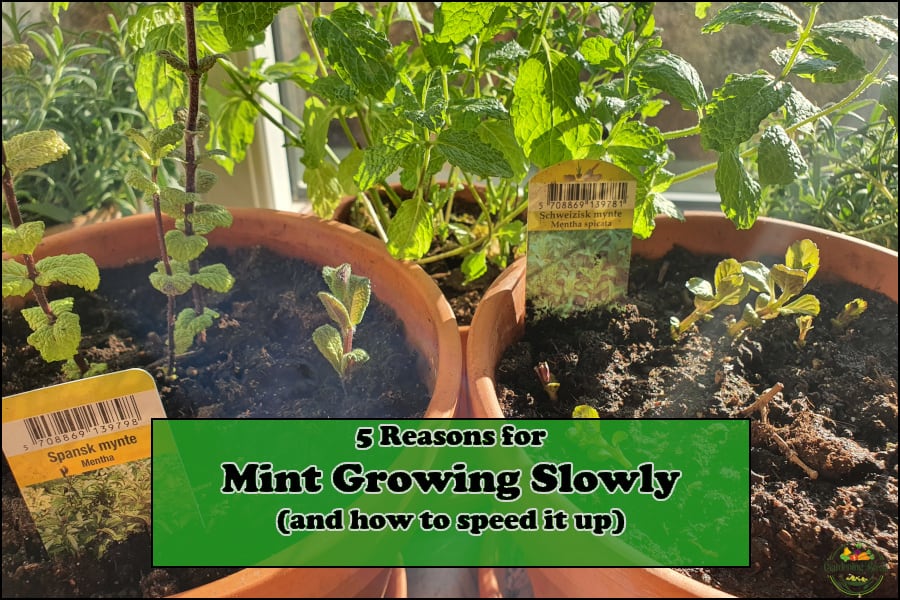
It may be a bit alarming if your mint plant begins to grow really slowly after it has grown fast for some time, but there is always an explanation for why it happens and a way to solve it. In this article, I cover both.
I have made a checklist with the most likely reasons why a mint plant would grow slowly to make it as easy as possible for your to go through it and identify your specific problem. I have, of course, also explained how you solve each of the problems.
Keep in mind that mint plants slow down their growth and, in most cases, stop it entirely during the winter, so it is winter, that might be the only reason why your mint is not really growing right now, but there might also be another reason, so keep reading.
If it is not winter and your mint plant is still growing very slowly, chances are something is wrong, so keep reading as I list the potential causes and solutions below.
1. Check if Your Mint Is Rootbound
It is very common for mint plants to become rootbound. In fact, it is one of the most common reasons why mint plants grow slowly or stop growing entirely. It happens gradually as the roots run out of room to grow, and it causes the plant to grow slower and slower and eventually stop entirely.

How to check:
Check if your mint plant is rootbound by carefully lifting it out of its pot. Grab the plant near the base to avoid damaging it and pull it out slowly. If you can see roots covering everything like in my photo above, you should take action.
Here is why your plant is rootbound and what you should do about it.
Cause:
Plants become rootbound when they have too little room to grow. It often happens to mint and other herbs from supermarkets as they usually plant too many seeds in a tiny plastic pot. When plants become rootbound, they will grow slower and slower and eventually stop.
Solution:
If your mint plant is rootbound, it should be transplanted into a bigger pot. If the plant is very big, it is a good idea to split it into four parts before transplanting them as four individual plants.
To split a big mint plant into multiple plants, you can use scissors or a knife to cut them. It won’t hurt the plant too much if you cut some of the roots, but try to keep as many roots as possible intact.
Transplant it into a larger pot with more soil than before. That way the roots have plenty of room to continue growing.
I have written an article where I go a lot more into detail about why it is important that plants have enough space and what happens if they don’t. You can find that article on this link.
2. Make Sure Your Mint Is Not Overwatered
Overwatering is one of the most common problems people have when growing mint. It can damage the roots and, in severe cases, kill the entire plan. Overwatering leads to an oxygen deficiency in the soil and with time even makes the roots rot, which makes the plants grow slower or stop entirely if the problem is severe.
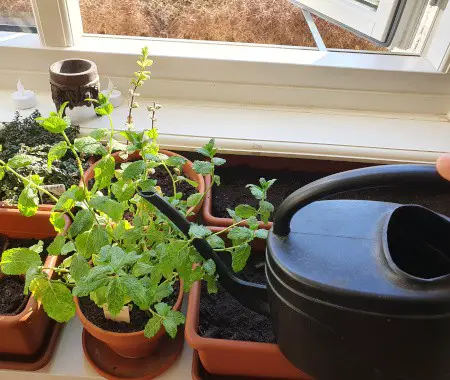
How to check:
Common signs of overwatering mint are wilting, leaves turning yellow and brown, and the plant doesn’t liven up when it is watered, which it would otherwise normally do. These symptoms are very similar to those of underwatering, which is one of the reasons why many people overwater their plants, and I have certainly also done it before, but luckily I know better now.
To make sure your plant is overwatered and not underwatered, touch the soil. If it is wet and soggy and water drips from it when you squeeze it, plus your plant is showing the symptoms I described above, it is very likely overwatered. If the soil is completely dry, it is probably underwatered.
Cause:
As the word indicates, overwatering is when plants get too much water but don’t worry if you give your mint plants too much water once or for a short period of time. Mint plants can take quite a bit before overwatering causes damage, but because it happens to the roots, the damage is hard to identify early, which is the reason people often overwater their plants for several weeks, which is enough to cause damage to the plants.
Solution:
To save an overwatered mint plant, consider transplanting it to a larger pot with fresh soil, where the roots have room to grow. The larger the plant’s root system is, the less likely it is to be overwatered.
If the overwatering is not so severe yet, you don’t have to transplant it yet, but instead, allow the top of the soil to dry, but make sure it is only the top of the soil that dries and not all of it, as that can also damage the plant, so keep the soil moist but never too wet. Only water when the top of the soil is dry.
For a more thorough guide on how to tell if your mint plant is overwatered and how to save it, check out this post.
3. Make Sure Your Mint Has Good Growing Conditions
All plants have some basic needs when it comes to their growing conditions. If they are not met, the plant will grow slowly or not at all. The conditions include sunlight, temperature, watering, soil type and pH, and spacing.
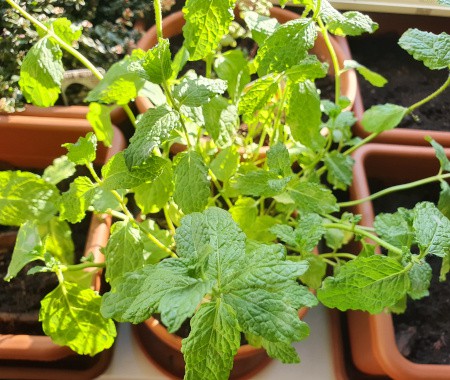
If your mint plant is growing slowly, there is a good chance it is because it doesn’t have good enough growing conditions.
Instead of a “Cause” and a “Solution” section like I wrote earlier in this article, I have made a table to give you an easy overview of what growing conditions your mint plant needs to grow as fast and be as productive as possible.
Here is a simple overview of what growing conditions mint plants need.
| Sunlight | Full or partial sun |
| Temperature | 65-70° F (about 18-21° C) |
| Watering | Only when the top of the soil is dry |
| Soil type | Nutrient-rich, moist soil |
| Soil pH | Slightly acidic to neutral soil pH |
| Spacing | Use a 12-inch (30 cm) pot |
You shouldn’t necessarily aim to follow this perfectly but rather see it as a good general rule of thumb, because a mint plant’s needs depend on a lot of things.
For example, mint likes a lot of sunlight and warm temperatures but also likes darkness and cold temperatures at night and during the winter. It also grows just fine at temperatures higher than those written in the table.
Mint also grows really well in a 12-inch pot as I wrote in the table above, but smaller or larger pots can work just fine too. The bigger the pot is, the more room the roots have to grow, and as a result of that, the bigger the plant will be. I have a guide for picking the best pot for your mint which you can find here.
Do your best to provide your mint plant with these conditions, but don’t worry if you can’t get it perfect. Your mint plant will love you for it and reward you with rapid growth and production.
4. Make Sure Your Mint Plant is Getting Enough Nutrients
Like all other plants, mint needs a certain type of nutrients in a certain amount to grow optimally. If it doesn’t get these, it will grow much slower than otherwise.
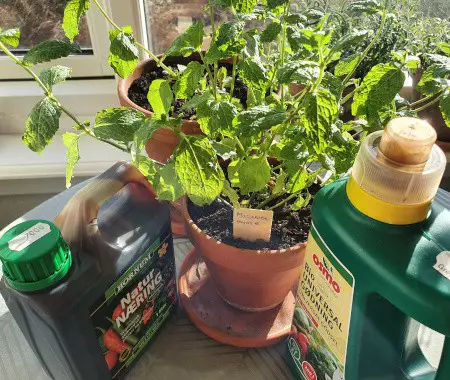
How to check:
Common signs that a mint plant isn’t getting the nutrients it needs are yellowing leaves and stunted plant and leaf growth. A good rule of thumb is that the darker your soil is, the more nutritious it is, and if it is light brown or pale, or almost gray looking, it likely doesn’t have enough nutrients for mint to thrive.
Cause:
As plants grow, or more specifically as their root systems grow, they use more and more nutrients, so unless it is growing in nutrient-rich soil (which mint should) or you add nutrients to it, the plant won’t grow as fast as it could.
Solution
The solution when your mint plant is lacking nutrients is simply to add some nutrients to the soil by using fertilizer. I have two different recommendations for this, so see which one you prefer and use that.
In a paper from Utah State University, Kristie Buckland and Dan Drost, Vegetable Specialists, recommend fertilizing mint by using a slow-release, complete fertilizer that you mix into the soil. They recommend using one teaspoon of 16-16-16 fertilizer per plant once the plants begin to grow in the spring.
I personally use a slightly different method that a gardener from my favorite garden center told me she had used for many years. I use an all-round vegetable fertilizer in the recommended amount that I mix into the water I water my mint plants with about once every two weeks. Small plants can’t take as much fertilizer as bigger plants, so if your mint plant is small, you should not fertilize it more often than every four weeks.
Overfertilizing can be just as harmful as under-fertilizing, if not more, so be careful not to use more than the recommended amount and look out for the signs I mentioned above.
5. Know That Small Plants Grow Slower Than Big Ones
One reason why your mint is growing slowly might simply be that it is very small. Plants typically grow at an exponential rate, so it will take some time in the beginning before you see a notable difference every day, but once your plant is larger, you will be able to see its growth day by day.
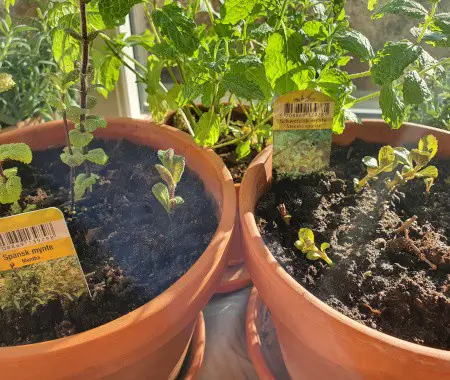
The photo above shows three of my mint plants, and as you can see, they have very different sizes. The large one in the back grows by almost an inch (2.5 cm) in every direction every day, while the two smaller ones in the front grow much slower.
I wanted to include this because I have seen people have unrealistic expectations for how fast mint grows. It might seem obvious to some, but if you’re new to growing herbs and vegetables, you might not know that they grow exponentially, meaning that you should not expect much in the beginning.
Keep taking good care of your mint, and it will reward you with rapid growth and bountiful harvests.

